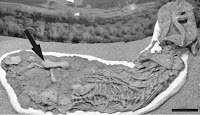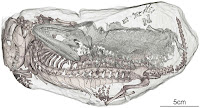The
Burnetiamorphs are a poorly understood group of Permian Theraspids
(Theraspids are the group which gave rise to and and include the
living Mammals, though Burnetiamorphs are not thought to be
particularly closely related to the earliest Mammals or their direct
ancestors) known from Southern and East Africa and Russia. The group
has a somewhat limited fossil record; by the end of the twentieth
century only two species had been described, one from South Africa
and one from Russia, though since then the number has risen to ten
species. The most commonly preserved part of Burnetiamorphs is a
heavy bone boss, made up of the fused and thickened bones of the
occipital region and the upper part of the braincase, though it is
often hard to identify the different bone components in these dense
structures, making them of limited use for understanding
relationships within the group.
In a
paper published in the journal Palaeontologia Africana on 23 March
2016, Christian Kammerer of the Museum für Naturkunde at the
Leibniz-Institut für Evolutions- und Biodiversitätsforschung and
the Evolutionary Studies Institute at the University of theWitwatersrand, records two previously undescribed Burnetiamorph
specimens from museum collections. Both specimens originate in the
Karoo Basin of South Africa, and both are considered by Kammerer to
be too fragmentary to assign to a species, but they nevertheless
provide insights into this little known group.
The first
specimen described, TM 4305, comes from the collection of the Ditsong National Museum of Natural History in Pretoria. It comprises a
weathered and only particularly prepared skull fragment, including
the interorbital region, temporal region and dorsal occiput. Any
details of where or when, or by whom this specimen was collected
appear to have been lost, though it does have a label attached,
identifying it as coming from the Tapinocephalus Assemblage
Zone, making it Middle Permian in age.
TM 4305
in (A) right lateral, (B) left lateral, (C) anterior, (D) ventral and
(E) posterior views. nb, Nasal boss; or, orbit; po, postorbital bar;
sb, supraorbital boss; sp, sphenoid element; tf, temporal fenestra.
Kammerer (2016).
The
second specimen described, NHMUK R871, comes from the collection of
the Natural History Museum in London. This specimen comes with more
detailed location information, having been collected by
palaeontologist Thomas Bain (1797-1864) at a site in Tafelberg, Beaufort West,
which produced a number of other, more complete and more studied,
vertebrate fossils, all of which were assigned to the genus
Tropidostoma; the location is
therefore considered to be part of the Tropidostoma
Assemblage Zone, making it Late Permian in age.
This
specimen comprises a fragment of skull roof preserving the
interorbital region and temporal roof to the anterior edge of the
pineal foramen. It was originally identified as a 'Theriodont?
Reptile' and subsequently as a 'Deinocephalian', but both a
Deinocephalian in the Tropidostoma
Assemblage Zone and a Theriodont with the extent of bone fusion and
thickening seen in the specimen are highly unlikely. The pattern of
bone fusion is, however, consistent with a Burnetiamorph, and
Kammerer feels confident in assigning the specimen to this group.
NHMUK
R871 in (A) right lateral, (B) left lateral, (C) anterior and (D)
posterior views. mb, Median boss; sb, supraorbital boss. Kammerer
(2016).
See also...
 Dinocephalian Therapsids from the Middle Permian of the Karoo Basin, South Africa. The Dinocephalians were a group
of mostly large, herbivorous Therapsids (the group that also includes Dicnodonts and Mammals) known from the Middle Permian
of Russia, Central Asia, China...
Dinocephalian Therapsids from the Middle Permian of the Karoo Basin, South Africa. The Dinocephalians were a group
of mostly large, herbivorous Therapsids (the group that also includes Dicnodonts and Mammals) known from the Middle Permian
of Russia, Central Asia, China... Scavenging on the body of a Dicynodont Therapsid in the Late Permian of the Karoo Basin. Therapsids were a group of Synapsid Amniotes (the group of terrestrial
vertebrates that include the...
Scavenging on the body of a Dicynodont Therapsid in the Late Permian of the Karoo Basin. Therapsids were a group of Synapsid Amniotes (the group of terrestrial
vertebrates that include the... Strange bedfellows in an Early Triassic burrow from the Karoo. The Early Triassic Karoo Basin contain numerous preserved burrows of
small Tetrapods, interpreted as adaptations to a harsh, seasonally dry,
climate...
Strange bedfellows in an Early Triassic burrow from the Karoo. The Early Triassic Karoo Basin contain numerous preserved burrows of
small Tetrapods, interpreted as adaptations to a harsh, seasonally dry,
climate...
Follow Sciency Thoughts on Facebook.


